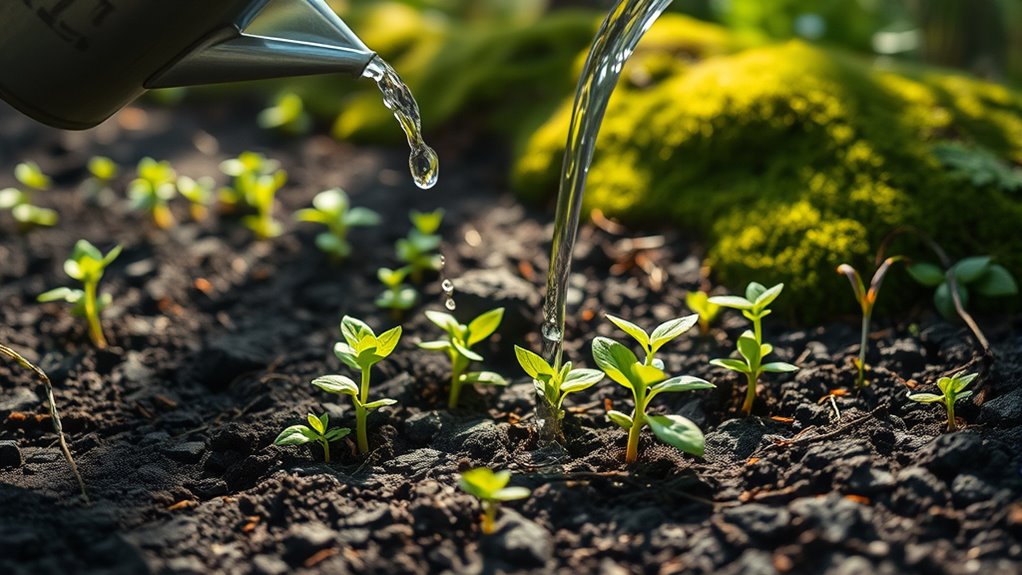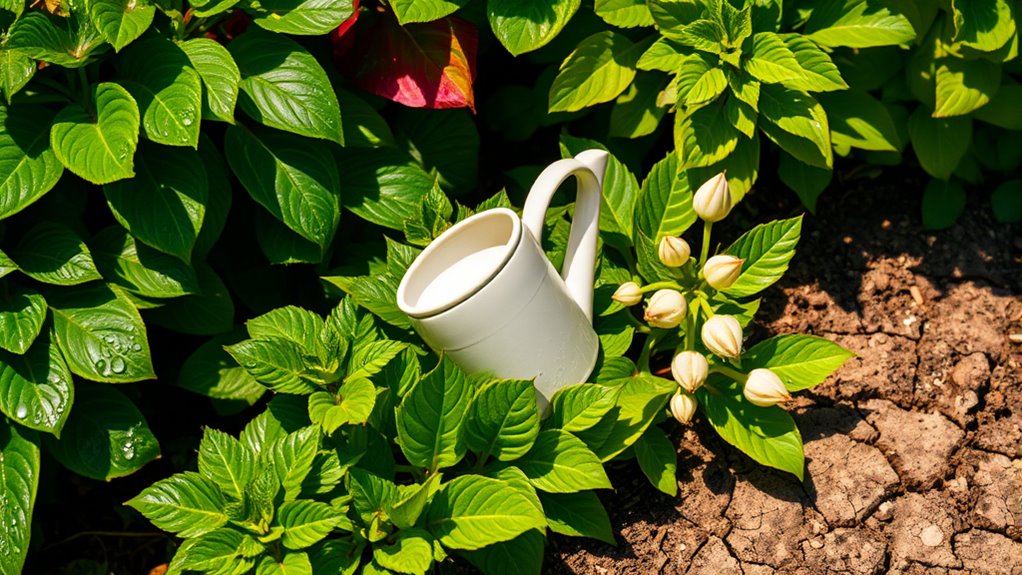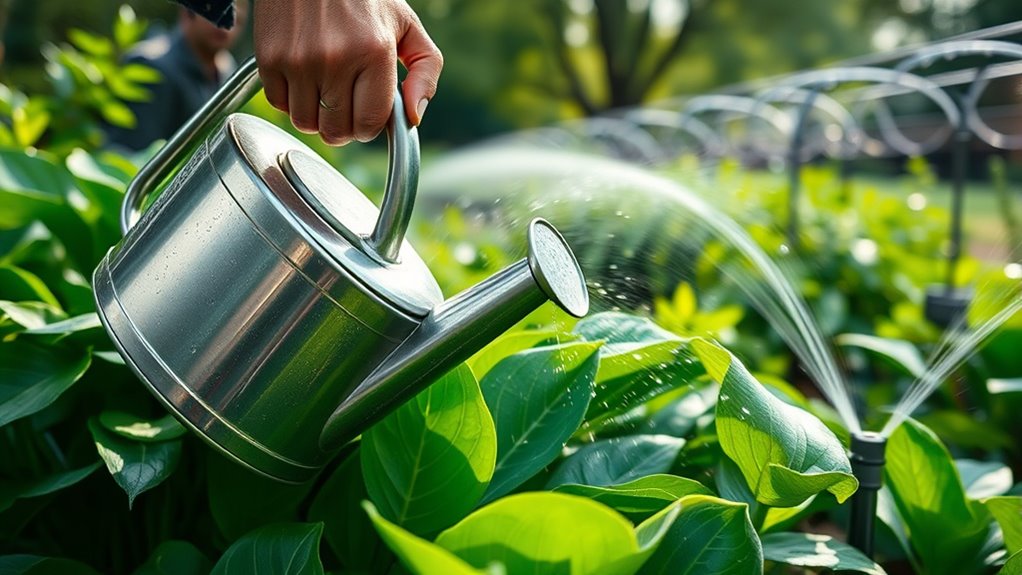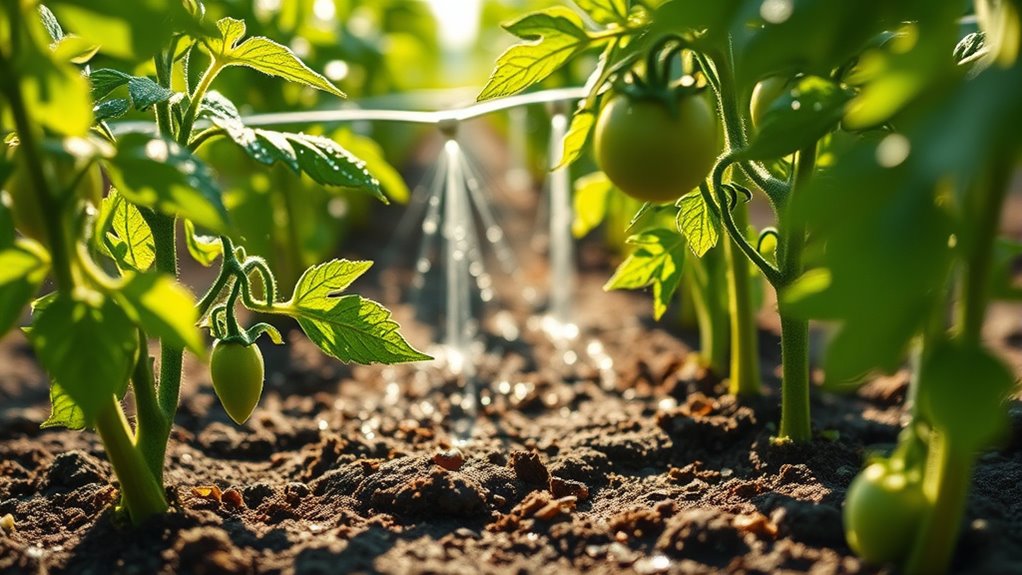Maintaining a consistent watering schedule is essential because it directly impacts your plants’ health and growth. By understanding each plant’s specific needs and paying attention to signs of dehydration or overwatering, you can prevent root rot, stress, and yellowing leaves. Soil type and environmental factors also play key roles. Sticking to a routine guarantees your plants stay resilient and thrive. Keep going, as more tips will help you master ideal watering practices for all your plants.
Key Takeaways
- Consistent watering routines prevent over- or underwatering, safeguarding plant health and growth.
- Proper schedules ensure roots remain moist without becoming waterlogged, reducing root rot risk.
- Tailoring watering frequency to plant type and environment optimizes resilience and nutrient absorption.
- Regular watering maintenance adapts to seasonal and environmental changes, maintaining plant vitality.
- Using tools and routines promotes sustainable care, minimizing stress and enhancing overall plant longevity.
The Impact of Watering Frequency on Plant Health

The frequency with which you water your plants directly affects their overall health and growth. When you water too often, roots may become weak and waterlogged, hindering root absorption and risking root rot. On the other hand, infrequent watering causes roots to dry out, reducing their ability to absorb water and nutrients effectively. You should also consider water vapor, which evaporates from the soil, especially in hot or dry conditions. Proper watering promotes a balanced environment where roots stay moist but not soaked, encouraging healthy root absorption. This balance ensures your plants can efficiently take up water and nutrients, boosting their resilience and growth. Adjusting watering frequency based on your plant’s needs keeps them healthy and thriving over time. Additionally, understanding plant hydration needs can help tailor your watering schedule to specific species and growing conditions.
Understanding Your Plants’ Water Needs

To meet your plants’ water needs, you should learn to spot signs of dehydration like wilting or dry soil. Keep in mind that different plants require different amounts of water, so adjusting your watering routine is essential. By understanding these cues and needs, you’ll help your plants thrive.
Recognizing Signs of Dehydration
Since plants can’t tell you when they’re thirsty, learning to recognize the signs of dehydration is essential for keeping them healthy. Watch for thirst cues like wilting leaves or leaves that appear droopy, which indicate low moisture levels. Dry, brittle edges on leaves also signal insufficient watering. You might notice soil pulling away from the pot’s edges, showing it’s too dry beneath the surface. A lack of turgor, where stems or leaves feel limp or soft, is another dehydration sign. Regularly check moisture levels by touching the soil or using a moisture meter. Understanding watering schedules and their importance helps you adjust watering before dehydration causes lasting damage, ensuring your plants stay vibrant and healthy.
Adjusting for Plant Type
Understanding your plants’ specific water needs is essential because not all plants require the same watering schedule. Some plants, like succulents, need infrequent watering, while others, such as ferns, thrive with consistently moist soil. To guarantee healthy growth, you must consider the plant’s type when planning your watering adjustment. Research each plant’s preferred moisture level and adjust your watering routine accordingly. This might mean watering deeply less often or providing lighter, more frequent waterings. Recognizing these differences allows you to meet their individual needs and prevent both under- and overwatering. Additionally, understanding plant watering techniques can help optimize hydration and promote healthier growth. By tailoring your plant specific watering approach, you give your plants the best chance to flourish and avoid common watering mistakes.
How Overwatering and Underwatering Affect Growth

Have you ever wondered how watering habits directly influence your plant’s growth? Overwatering can drown the roots, leading to root rot and stunted development. When roots sit in excessive moisture, they struggle to breathe, hindering root development and reducing their ability to absorb nutrients effectively. On the other hand, underwatering causes the soil to dry out completely, stressing the plant and preventing proper nutrient absorption. This limits the plant’s growth and weakens its overall health. Both extremes can lead to yellowing leaves, wilting, and even plant death if not corrected. Finding the right balance ensures healthy root development and essential nutrient uptake, which are critical for your plant’s growth and vitality. Proper watering habits are critical for a thriving, resilient plant.
The Role of Soil and Environment in Watering Practices

The type of soil and surrounding environment play a crucial role in determining how often and how much you should water your plants. Soil composition affects water retention—sandy soils drain quickly, requiring more frequent watering, while clay soils hold moisture longer. Environmental factors like temperature, humidity, and sunlight further influence watering needs. To understand these dynamics, consider this overview:
| Soil Type | Water Retention | Environmental Factors |
|---|---|---|
| Sandy | Drains fast, needs frequent watering | High temperatures increase watering needs |
| Clay | Holds water longer | Humidity reduces watering frequency |
| Loamy | Balanced moisture retention | Mild conditions, moderate watering |
| Rocky | Very quick drainage | Wind and sun can dry soil rapidly |
Additionally, understanding soil texture can help you better tailor your watering schedule for optimal plant health.
Signs That Indicate Your Plants Need More or Less Water

You can tell your plants need water when their leaves wilt or droop, signaling stress. Check the soil; if it’s dry, your plants likely need more water, but if it’s soggy, they may be overwatered. Recognizing these signs helps you adjust your watering schedule to keep your plants healthy. Additionally, implementing budgeting tips like tracking your expenses can help you allocate resources more effectively for plant care or gardening supplies.
Wilting or Drooping Leaves
Wilting or drooping leaves often signal that your plant isn’t getting the right amount of water. If the leaves appear limp and discolored, it may be a sign of overwatering, which can lead to root rot. Root rot occurs when excess water suffocates the roots, preventing them from absorbing nutrients and water properly. This stress causes leaves to droop and turn yellow or brown. Conversely, if your plant is under-watered, leaves may also droop but usually feel dry and brittle. To determine the cause, check the soil moisture and inspect the roots if possible. Proper watering helps maintain healthy leaf turgor and prevents issues like leaf discoloration or root rot, ensuring your plant stays vibrant and strong. Additionally, understanding watering schedules and adjusting them accordingly can significantly improve plant health and resilience.
Dry or Soppy Soil
When soil feels either excessively dry or overly soggy, it’s a clear sign your plant needs attention. Soil moisture levels are key indicators of whether you should water more or less. If the soil is dry and pulls away from the edges of the pot, your plant probably needs a thorough watering. On the other hand, if the soil is soppy or stays wet for days, you’re likely overwatering. Adjust your watering habits accordingly: water only when the soil is dry to the touch, ensuring proper drainage to avoid sogginess. Consistently monitoring soil moisture helps maintain healthy roots and prevents both drought stress and root rot. Developing a careful watering schedule will keep your plants thriving and reduce guesswork. Using durable materials for your watering tools and containers can also improve the effectiveness of your watering routine.
Creating a Custom Watering Schedule for Different Plants

Creating a custom watering schedule for different plants requires understanding their unique needs and adjusting your routine accordingly. To guarantee optimal plant hydration, consider these key factors:
- Identify watering frequency — some plants prefer weekly watering, while others need more or less often.
- Observe soil moisture — check soil moisture levels regularly to prevent over- or underwatering.
- Know plant type needs — succulents need less water, whereas tropical plants thrive with consistent moisture.
- Adjust seasonally — watering needs change with the seasons, so modify your routine accordingly.
- Utilize appropriate tools — using watering tools can help ensure precise and consistent watering practices.
Tailoring your watering schedule helps maintain healthy plants and prevents issues caused by improper watering frequency. Remember, understanding each plant’s specific requirements is the key to successful plant care.
Tips for Consistent and Effective Watering Routines

Maintaining a consistent and effective watering routine guarantees your plants stay healthy and thrive over time. To achieve this, leverage watering technology like timers or drip systems to guarantee regularity, even when you’re busy. Adjust your watering schedule based on plant hydration needs and environmental conditions, such as temperature and humidity. Monitor soil moisture levels regularly with a moisture meter to prevent over or under-watering. Consistency is key—watering at the same time each day helps your plants adapt and absorb nutrients effectively. Keep an eye on weather changes; rain can affect your schedule. Using reliable watering technology and paying close attention to your plants’ hydration cues, you create a routine that promotes healthy growth and minimizes stress.
Frequently Asked Questions
How Does Watering Schedule Influence Long-Term Plant Survival?
Your watering schedule directly affects long-term plant survival by maintaining proper soil moisture, which keeps roots healthy. When you water consistently and appropriately, you prevent the soil from drying out or becoming waterlogged, both of which harm root health. This balance ensures your plants have access to necessary nutrients and oxygen, promoting strong growth and resilience over time. Proper watering habits are crucial for your plants’ lasting vitality.
Can Inconsistent Watering Harm Plant Root Systems?
Inconsistent watering can severely harm your plant’s root systems, with studies showing that uneven moisture levels cause root stress and reduce nutrient absorption. When soil moisture fluctuates, roots struggle to grow strong, leading to weak root health and increased vulnerability to diseases. You need a steady watering schedule to maintain soil moisture at ideal levels, ensuring your plants develop robust roots and stay healthy long-term.
What Tools Help Monitor Proper Watering Intervals?
You can use soil moisture sensors and watering timers to monitor proper watering intervals effectively. Soil moisture sensors help you check if the soil is adequately moist, preventing over- or under-watering. Watering timers automate the process, ensuring you water consistently and at the right times. Together, these tools make it easier to maintain healthy plants, save water, and prevent root damage caused by inconsistent watering.
How Do Seasonal Changes Affect Watering Needs?
Seasonal changes markedly impact your watering needs because soil moisture levels fluctuate with weather patterns. During hotter months, evaporation rates increase, causing soil moisture to decrease faster, so you need to water more frequently. In cooler seasons, evaporation slows, and plants require less water. Keep an eye on soil moisture to adjust your schedule accordingly, ensuring your plants stay healthy without overwatering or underwatering.
Are There Specific Signs of Drought Stress in Different Plant Types?
You’ll notice drought symptoms like wilting, yellowing, or browning leaves in many plants, but plant indicators vary. For example, succulents may store water longer, showing less stress, while grasses turn brown quickly. Keep an eye out for drooping stems or dry soil as signs of drought stress. Recognizing these plant indicators helps you adjust watering before damage occurs, ensuring healthy growth even during dry spells.
Conclusion
Remember, watering your plants correctly can mean the difference between thriving and withering away. While overwatering might drown roots, underwatering leaves them parched and lifeless. Striking the right balance isn’t just about healthy growth—it’s about nurturing your plants’ vitality and your own connection to nature. By understanding their needs and adjusting your routine, you’ll find joy in watching them flourish, knowing your care makes all the difference.










